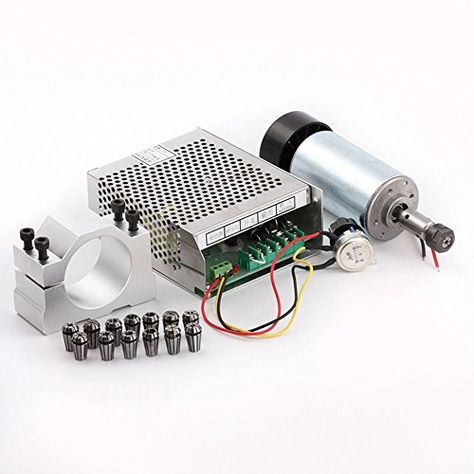
How to Choose Accessories for Your CNC Router?
1. Understand Your Needs: What Will You Do with Your CNC Router?
Before diving into specific accessories, first clarify your primary applications. Will you be carving wood, metal, plastic, or other materials? Do you need high precision, or are speed and batch production more important?
-
Material Type: Different materials require different types of cutting tools and spindles. For instance, engraving metal typically demands a higher-power spindle and tougher bits.
-
Project Scale: If you plan to create large workpieces, you might need a larger work area and longer travel.
-
Precision Requirements: For intricate details and high-precision projects, you'll want to consider high-resolution stepper motors or servo motors, as well as high-quality linear guides and ball screws.
-
Budget: Accessory prices vary widely, so setting a budget will help you narrow down your choices.
2. Core Accessory Selection Guide
2.1 Spindle
The spindle is the "heart" of your CNC router, responsible for rotating the cutting tool.
-
Power: Spindle power determines the hardness of the material it can handle.
-
Low Power (e.g., 500W - 1.5kW): Suitable for soft materials like wood, plastics, and PCBs.
-
Medium Power (e.g., 2.2kW - 4.5kW): Good for wood, acrylic, and aluminum, making it a versatile choice for most hobbyists.
-
High Power (e.g., 5.5kW and above): Designed specifically for metal machining and heavy-duty cutting.
-
-
Cooling Method:
-
Air Cooled: Simple structure, easy to maintain, but relatively noisy.
-
Water Cooled: Excellent heat dissipation, low noise, but requires an additional pump and tank, and maintenance is slightly more complex.
-
-
RPM (Revolutions Per Minute): High RPM is essential for fine engraving and high-speed cutting.
2.2 Drive System: Stepper Motors vs. Servo Motors
The drive system controls the movement of the CNC axes, directly impacting precision and speed.
-
Stepper Motors:
-
Pros: Lower cost, easy to control, suitable for most hobby and small commercial applications.
-
Cons: Can lose steps at high speeds (missed steps), and torque decreases at higher speeds.
-
-
Servo Motors:
-
Pros: High precision, maintain high torque at high speeds, won't lose steps, and feedback systems ensure accurate positioning.
-
Cons: Higher cost, more complex control systems.
-
When to Choose: If you need high precision, high speed, or are working with heavy materials, servo motors are the better choice.
-
2.3 Motion System: Ball Screws vs. Rack and Pinion
The motion system converts motor rotation into linear movement.
-
Ball Screws:
-
Pros: High precision, minimal backlash, suitable for high-precision and small to medium-sized CNC routers.
-
Cons: Limited in length, relatively higher cost.
-
-
Rack and Pinion:
-
Pros: Ideal for long-travel machines, lower cost, strong load capacity.
-
Cons: Relatively lower precision, potential for backlash, noisier.
-
When to Choose: For large gantry-style CNC routers, rack and pinion systems are a common choice.
-
2.4 Linear Guides
Linear guides ensure smooth and precise motion.
-
Round Rails: Lower cost, suitable for light-duty applications.
-
Square Rails / Linear Bearings: High precision, strong load capacity, smooth operation, and are standard on professional-grade CNC routers.
3. Other Essential Accessories
-
Controller Card/System: Choosing a user-friendly and powerful controller is vital. Common options include Mach3, GRBL, DSP controllers, etc. They dictate how you interact with your machine.
-
Cutting Tools/Bits: Select different types and sizes of bits based on the material you're processing and the detail required, such as end mills, engraving bits, ball nose bits, etc. Regularly replacing worn-out tools improves machining quality.
-
Clamping System: Ensure your workpiece is securely fixed to the table to prevent movement during machining. Vacuum tables, T-slot tables, and vises are common choices.
-
Limit Switches: Prevent the machine from exceeding its travel limits, protecting both the machine and the workpiece.
-
E-Stop Button: Instantly stops the machine in emergencies, ensuring operational safety.
-
Dust Collection System: For wood and some plastic processing, a good dust collection system keeps your workspace clean, prolongs machine life, and improves operator health.
-
Coolant System: Especially important for metal machining, it reduces tool temperature, extends tool life, and improves cutting quality.
